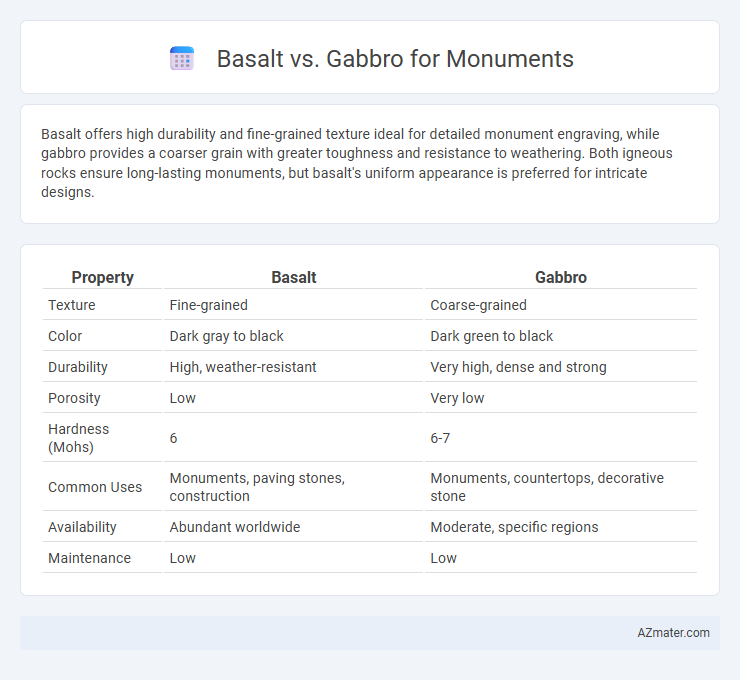Basalt offers high durability and fine-grained texture ideal for detailed monument engraving, while gabbro provides a coarser grain with greater toughness and resistance to weathering. Both igneous rocks ensure long-lasting monuments, but basalt's uniform appearance is preferred for intricate designs.
Table of Comparison
| Property | Basalt | Gabbro |
|---|---|---|
| Texture | Fine-grained | Coarse-grained |
| Color | Dark gray to black | Dark green to black |
| Durability | High, weather-resistant | Very high, dense and strong |
| Porosity | Low | Very low |
| Hardness (Mohs) | 6 | 6-7 |
| Common Uses | Monuments, paving stones, construction | Monuments, countertops, decorative stone |
| Availability | Abundant worldwide | Moderate, specific regions |
| Maintenance | Low | Low |
Introduction to Basalt and Gabbro
Basalt and gabbro are both igneous rocks commonly used in monument construction, differing primarily in texture and formation. Basalt is a fine-grained volcanic rock formed from rapid cooling of lava at the Earth's surface, known for its dark color and durability. Gabbro is a coarse-grained intrusive rock crystallized slowly beneath the Earth's surface, exhibiting a similar mineral composition but with larger, visible crystals ideal for detailed monument work.
Geological Origins and Formation
Basalt and gabbro both originate from mafic magma but differ in cooling rates and formation environments, impacting their texture and suitability for monuments. Basalt forms from rapid cooling of lava at the Earth's surface, resulting in fine-grained, dense rock often used for durable, weather-resistant monuments. Gabbro crystallizes slowly beneath the Earth's crust, creating coarse-grained texture with visible mineral crystals, preferred for large, polished memorials due to its strength and aesthetic appeal.
Physical Properties: Hardness and Durability
Basalt and gabbro are both igneous rocks with high hardness, ranking around 6 to 7 on the Mohs scale, making them excellent choices for long-lasting monuments. Basalt's fine-grained texture offers superior resistance to weathering and abrasion, while gabbro's coarse-grained structure provides exceptional toughness and structural integrity. Both stones exhibit excellent durability, but basalt typically performs better in harsh environmental conditions due to its dense, uniform mineral composition.
Color and Texture Differences
Basalt exhibits a fine-grained, dense texture with dark gray to black color, making it ideal for sleek, modern monuments. Gabbro has a coarse-grained texture with larger mineral crystals and varies from dark gray to black with greenish undertones, presenting a more rugged and natural appearance. The color contrast and texture differences between basalt and gabbro influence their visual impact and durability in monument applications.
Workability for Sculpting and Carving
Basalt is dense and fine-grained, offering moderate workability for detailed sculpting, but its hardness can pose challenges for intricate carving. Gabbro's coarse-grained texture allows for easier shaping and smoother finishes, making it more favorable for large, detailed monuments. Both stones provide durability, but gabbro's crystalline structure gives it an edge in precision work.
Weather Resistance and Longevity
Basalt exhibits superior weather resistance due to its dense, fine-grained structure that minimizes water absorption and erosion, making it ideal for monuments exposed to harsh environmental conditions. Gabbro, although durable and coarse-grained, is more susceptible to chemical weathering and may degrade faster when exposed to acidic rain or freeze-thaw cycles. The longevity of basalt in outdoor monuments generally surpasses gabbro, ensuring sustained structural integrity and aesthetic appeal over time.
Aesthetic Appeal in Monument Design
Basalt offers a fine-grained, uniform texture with deep black or dark gray hues that create a sleek and modern aesthetic in monument design, while gabbro displays a coarse-grained structure with a speckled appearance featuring black and white minerals that evoke a more traditional and natural look. The consistent coloration of basalt enhances the monument's visual impact through clean lines and smooth surfaces, making it ideal for minimalist commemorative art. Gabbro's varied coloration and texture provide a dynamic visual depth, appealing to designers seeking a bold, intricate pattern that emphasizes natural stone beauty.
Cost Comparison: Sourcing and Processing
Basalt typically costs less than gabbro due to its more abundant availability and lower extraction expenses, making it a budget-friendly choice for monuments. Gabbro's denser grain structure requires more intensive processing and polishing, resulting in higher labor and machinery costs. When considering sourcing, basalt deposits are widespread and easier to access, while gabbro quarries are often limited, adding transportation expenses to the overall cost.
Environmental Impact of Quarrying
Basalt quarrying generally has a lower environmental impact than gabbro due to its more widespread availability and often less intensive extraction processes. Both basalt and gabbro quarrying disrupt local ecosystems, but basalt's durability allows for thinner cuts, reducing material waste. Rehabilitation of basalt quarries tends to be more straightforward, contributing to its preference in monuments considering ecological sustainability.
Best Practices for Choosing Between Basalt and Gabbro
Basalt offers high durability and a fine-grained texture ideal for detailed monument engravings, making it suitable for outdoor memorials exposed to harsh weather. Gabbro, being coarser and denser with a polished finish, provides a more lustrous appearance and resists abrasion, preferred for monumental bases or markers requiring a refined aesthetic. When choosing between basalt and gabbro, consider factors such as grain texture, weather resistance, maintenance needs, and desired visual impact to ensure optimal longevity and appearance in the monument's specific environment.

Infographic: Basalt vs Gabbro for Monument
 azmater.com
azmater.com